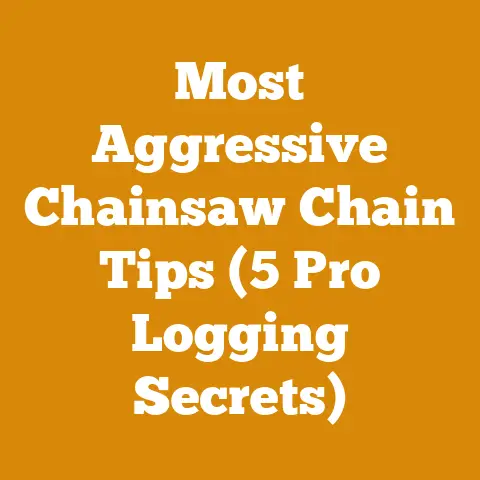Husqvarna Used Chainsaw Essentials (Top Classic Models Explained)
Imagine this: a biting wind whips through the skeletal branches of winter-bare trees. A few months ago, these trees stood tall and proud. Now, they lie in a tangled heap, waiting to be transformed. The air is thick with the scent of freshly cut wood and the metallic tang of chainsaw oil. That was the “before.” The “after” is a neat stack of seasoned firewood, ready to warm homes and hearths through the long winter months. The key to that transformation? A reliable chainsaw. For many, including myself, a used Husqvarna chainsaw offers the perfect balance of power, durability, and affordability. I’ve spent countless hours in the woods, relying on these machines to get the job done. And in this guide, I’ll share my knowledge of Husqvarna’s classic models, helping you choose the right used chainsaw for your needs.
Husqvarna Used Chainsaw Essentials: Top Classic Models Explained
Finding the right used chainsaw can be a daunting task. There are so many models, each with its own strengths and weaknesses. That’s why I’ve created this guide, focusing on some of Husqvarna’s most reliable and sought-after classic models. I will cover everything from identifying models to assessing their condition, ensuring you make an informed decision.
Why Choose a Used Husqvarna Chainsaw?
Husqvarna has a long and storied history of producing high-quality chainsaws. Their reputation for durability, power, and reliability makes them a popular choice for both professionals and homeowners. Buying a used Husqvarna chainsaw can offer several advantages:
- Cost Savings: Used chainsaws are significantly cheaper than new ones, allowing you to save money without sacrificing quality.
- Proven Reliability: Classic Husqvarna models have stood the test of time. Their longevity speaks volumes about their build quality.
- Availability of Parts: Parts for many older Husqvarna models are still readily available, making repairs and maintenance relatively easy.
- Performance: Classic models often provide comparable performance to newer saws, especially for common tasks like felling small trees and bucking firewood.
Understanding Husqvarna Model Numbers
Husqvarna uses a numbering system to identify its chainsaws. Understanding this system can help you quickly assess a chainsaw’s size, power, and intended use.
- First Digit(s): Generally indicates the engine displacement or relative power of the saw. Higher numbers typically mean larger, more powerful saws.
- Following Digits: Further refine the model identification, sometimes indicating specific features or improvements.
- Letters (if any): May indicate specific variations or features, such as “G” for heated handles or “XP” for professional-grade models.
For example, the Husqvarna 455 Rancher is a mid-sized chainsaw with a 55cc engine. The “Rancher” designation indicates that it’s designed for general use around a farm or property.
Top Classic Husqvarna Chainsaw Models
Here are some of Husqvarna’s most popular and reliable classic chainsaw models that are worth considering on the used market:
Husqvarna 455 Rancher
The Husqvarna 455 Rancher is a true workhorse. I’ve seen these saws used and abused, yet they keep on ticking. Its durable construction and reliable engine make it a favorite among homeowners and occasional users.
- Engine Displacement: 55.5cc
- Bar Length: Typically 16-20 inches
- Weight: Around 12.8 lbs (without bar and chain)
- Pros: Versatile, reliable, easy to start, readily available parts.
- Cons: Can be a bit heavy for extended use, not ideal for very large trees.
- Typical Uses: Felling small to medium-sized trees, bucking firewood, limbing.
- My Experience: I used a 455 Rancher for years to clear storm damage on my property. It consistently started on the first or second pull, even after sitting idle for months.
- Things to look for when buying used: Check the compression, inspect the fuel lines for cracks, and ensure the chain brake is functioning correctly.
- Maintenance Tips: Regularly clean the air filter, sharpen the chain, and use fresh fuel.
Husqvarna 460 Rancher
The Husqvarna 460 Rancher is often considered the upgraded version of the 455. I’ve found that it offers a bit more power and torque, making it suitable for slightly larger tasks.
- Engine Displacement: 60.3cc
- Bar Length: Typically 18-24 inches
- Weight: Around 13 lbs (without bar and chain)
- Pros: More powerful than the 455, durable, reliable.
- Cons: Can be heavy, fuel consumption slightly higher than the 455.
- Typical Uses: Felling medium-sized trees, bucking large firewood, clearing brush.
- My Experience: I used a 460 Rancher for a small logging project, felling and bucking trees up to 24 inches in diameter. It handled the job with ease.
- Things to look for when buying used: Inspect the crankshaft bearings for play, check the oiler system for proper lubrication, and ensure the anti-vibration system is in good condition.
- Maintenance Tips: Regularly check and adjust the chain tension, clean the spark plug, and use a fuel stabilizer when storing the saw for extended periods.
Husqvarna 372XP
The Husqvarna 372XP is a professional-grade chainsaw known for its power and performance. I’ve seen professional loggers swear by this model. It’s a bit heavier than the Rancher models, but the extra power is worth it for demanding tasks.
- Engine Displacement: 70.7cc
- Bar Length: Typically 18-28 inches
- Weight: Around 14.6 lbs (without bar and chain)
- Pros: Powerful, durable, designed for heavy-duty use.
- Cons: Can be expensive, requires more maintenance than homeowner models, heavier.
- Typical Uses: Felling large trees, professional logging, heavy-duty firewood cutting.
- My Experience: I worked alongside a logger who used a 372XP daily. He praised its reliability and power, saying it was the only saw he trusted for big jobs.
- Things to look for when buying used: Check the cylinder for scoring, inspect the piston rings for wear, and ensure the carburetor is properly adjusted.
- Maintenance Tips: Use high-quality two-stroke oil, regularly clean the cylinder fins, and have the saw professionally serviced annually.
Husqvarna 450
The Husqvarna 450 is a lighter-duty saw that is popular for homeowners with smaller properties. I’ve found that it’s easy to handle and maneuver, making it a good choice for limbing and light firewood cutting.
- Engine Displacement: 50.2cc
- Bar Length: Typically 16-18 inches
- Weight: Around 11.3 lbs (without bar and chain)
- Pros: Lightweight, easy to start, good for smaller tasks.
- Cons: Not as powerful as the Rancher models, not suitable for large trees.
- Typical Uses: Limbing, light firewood cutting, pruning.
- My Experience: My neighbor uses a 450 to maintain his property. He says it’s perfect for trimming branches and cutting small firewood.
- Things to look for when buying used: Check the chain brake, inspect the fuel filter, and ensure the anti-vibration system is working properly.
- Maintenance Tips: Regularly sharpen the chain, clean the air filter, and use fresh fuel.
Husqvarna 61
The Husqvarna 61 is an older model, but it’s known for its robust construction and simple design. I’ve seen these saws last for decades with proper care. It’s a good choice for someone who wants a reliable and easy-to-maintain chainsaw.
- Engine Displacement: 61cc
- Bar Length: Typically 16-20 inches
- Weight: Around 13.2 lbs (without bar and chain)
- Pros: Durable, simple design, easy to maintain.
- Cons: Older technology, can be harder to find parts, may require more frequent maintenance.
- Typical Uses: Felling small to medium-sized trees, bucking firewood, general property maintenance.
- My Experience: I inherited a Husqvarna 61 from my grandfather. It’s an old saw, but it still runs strong. I use it for occasional firewood cutting.
- Things to look for when buying used: Check the compression, inspect the fuel lines for cracks, and ensure the oiler system is working properly.
- Maintenance Tips: Use high-quality two-stroke oil, regularly clean the air filter, and keep the chain sharp.
Assessing the Condition of a Used Chainsaw
Before you buy a used chainsaw, it’s crucial to assess its condition thoroughly. Here’s a checklist of things to look for:
Visual Inspection
- Overall Appearance: Look for signs of excessive wear and tear, damage, or neglect.
- Bar and Chain: Check the bar for straightness, wear, and damage. Inspect the chain for sharpness, damage, and proper tension.
- Housing: Look for cracks, breaks, or missing parts in the chainsaw housing.
- Fuel and Oil Tanks: Check for leaks or damage to the fuel and oil tanks.
- Air Filter: Inspect the air filter for dirt, debris, and damage.
- Spark Plug: Remove the spark plug and inspect it for fouling or damage. A healthy spark plug should be clean and dry.
Mechanical Inspection
- Compression: Check the compression by pulling the starter cord. You should feel strong resistance. Low compression can indicate worn piston rings or a damaged cylinder.
- Chain Brake: Test the chain brake to ensure it engages properly and stops the chain quickly.
- Throttle and Controls: Check the throttle and other controls to ensure they operate smoothly and correctly.
- Oiler System: Start the chainsaw and check that the oiler system is lubricating the chain properly.
- Starting: Try starting the chainsaw. It should start relatively easily and run smoothly.
- Idling: Once started, the chainsaw should idle smoothly without stalling or revving excessively.
- Acceleration: Test the chainsaw’s acceleration by quickly squeezing the throttle. It should respond quickly and smoothly.
Ask Questions
- Usage History: Ask the seller about the chainsaw’s usage history, including how often it was used, what types of tasks it was used for, and how well it was maintained.
- Maintenance Records: Ask if the seller has any maintenance records for the chainsaw.
- Repairs: Ask if the chainsaw has ever been repaired and, if so, what repairs were performed.
- Reason for Selling: Ask the seller why they are selling the chainsaw.
Common Problems with Used Chainsaws and How to Fix Them
Even well-maintained chainsaws can develop problems over time. Here are some common issues you might encounter with a used Husqvarna chainsaw and how to address them:
- Hard Starting: This can be caused by a dirty air filter, a fouled spark plug, old fuel, or a clogged carburetor. Clean or replace the air filter and spark plug, use fresh fuel, and clean or rebuild the carburetor if necessary.
- Stalling: This can be caused by a lean fuel mixture, a dirty air filter, or a clogged fuel filter. Adjust the carburetor, clean or replace the air filter, and replace the fuel filter.
- Low Power: This can be caused by a dull chain, low compression, or a clogged exhaust port. Sharpen the chain, check the compression, and clean the exhaust port.
- Chain Not Oiling: This can be caused by a clogged oil filter, a blocked oil line, or a faulty oil pump. Clean or replace the oil filter, clear the oil line, and replace the oil pump if necessary.
- Chain Brake Not Working: This can be caused by a broken brake band, a worn brake spring, or a damaged brake lever. Replace the brake band, spring, or lever as needed.
Safety First: Essential Chainsaw Safety Gear and Practices
Operating a chainsaw can be dangerous if proper safety precautions are not followed. I’ve seen firsthand the devastating consequences of chainsaw accidents. Always wear appropriate safety gear and follow safe operating practices.
Essential Safety Gear
- Chainsaw Chaps: These protect your legs from chainsaw cuts.
- Eye Protection: Safety glasses or a face shield protect your eyes from flying debris.
- Hearing Protection: Earplugs or earmuffs protect your hearing from the loud noise of the chainsaw.
- Gloves: Heavy-duty gloves provide a good grip and protect your hands.
- Steel-Toed Boots: Steel-toed boots protect your feet from falling logs and chainsaw cuts.
- Hard Hat: A hard hat protects your head from falling branches and other debris.
Safe Operating Practices
- Read the Manual: Always read and understand the chainsaw’s instruction manual before operating it.
- Inspect the Chainsaw: Before each use, inspect the chainsaw for any damage or loose parts.
- Start the Chainsaw Safely: Start the chainsaw on the ground, away from your body, and with the chain brake engaged.
- Maintain a Firm Grip: Always maintain a firm grip on the chainsaw with both hands.
- Keep a Safe Distance: Keep a safe distance from other people and obstacles.
- Avoid Cutting Above Shoulder Height: Cutting above shoulder height can be dangerous and tiring.
- Be Aware of Kickback: Kickback is a sudden and forceful reaction that can occur when the tip of the chainsaw bar comes into contact with an object. Be aware of the risk of kickback and take steps to avoid it.
- Never Cut Alone: Always work with someone else when operating a chainsaw.
- Take Breaks: Take frequent breaks to avoid fatigue.
- Store the Chainsaw Safely: Store the chainsaw in a safe place, out of the reach of children.
Maintaining Your Used Husqvarna Chainsaw
Regular maintenance is essential to keep your used Husqvarna chainsaw running smoothly and reliably. Here’s a maintenance schedule to follow:
Daily Maintenance
- Check the Chain Tension: Adjust the chain tension as needed.
- Sharpen the Chain: Sharpen the chain regularly to ensure optimal cutting performance.
- Clean the Air Filter: Clean the air filter to prevent engine damage.
- Check the Fuel and Oil Levels: Fill the fuel and oil tanks as needed.
- Inspect the Chainsaw: Look for any damage or loose parts.
Weekly Maintenance
- Clean the Spark Plug: Clean the spark plug to ensure proper ignition.
- Clean the Cylinder Fins: Clean the cylinder fins to prevent overheating.
- Check the Oiler System: Ensure the oiler system is lubricating the chain properly.
- Lubricate the Bar Sprocket: Lubricate the bar sprocket to reduce wear.
Monthly Maintenance
- Replace the Fuel Filter: Replace the fuel filter to prevent fuel contamination.
- Replace the Air Filter: Replace the air filter if it is damaged or excessively dirty.
- Inspect the Fuel Lines: Inspect the fuel lines for cracks or leaks.
- Inspect the Anti-Vibration System: Ensure the anti-vibration system is working properly.
Annual Maintenance
- Have the Chainsaw Professionally Serviced: Have the chainsaw professionally serviced to ensure it is in good working order.
- Replace the Spark Plug: Replace the spark plug annually, even if it looks good.
- Inspect the Piston and Cylinder: Inspect the piston and cylinder for wear or damage.
Where to Buy Used Husqvarna Chainsaws
You can find used Husqvarna chainsaws at a variety of locations, including:
- Online Marketplaces: Websites like eBay, Craigslist, and Facebook Marketplace are popular places to find used chainsaws.
- Local Classifieds: Check your local newspaper or online classifieds for used chainsaws for sale.
- Pawn Shops: Pawn shops often have used chainsaws for sale.
- Garage Sales: Keep an eye out for garage sales in your area.
- Equipment Dealers: Some equipment dealers sell used chainsaws.
- Friends and Neighbors: Ask your friends and neighbors if they have any used chainsaws for sale.
Negotiating the Price of a Used Chainsaw
When buying a used chainsaw, don’t be afraid to negotiate the price. Here are some tips for negotiating:
- Do Your Research: Before you start negotiating, research the fair market value of the chainsaw you are interested in.
- Point Out Flaws: Point out any flaws or problems you find with the chainsaw.
- Be Willing to Walk Away: Be willing to walk away from the deal if the seller is not willing to negotiate a fair price.
- Pay in Cash: Offering to pay in cash can sometimes help you get a better price.
- Be Polite and Respectful: Always be polite and respectful to the seller, even if you are not able to reach an agreement.
Case Studies: Real-World Examples of Used Husqvarna Chainsaws in Action
Here are a couple of case studies illustrating the value of a used Husqvarna chainsaw:
Case Study 1: Small-Scale Firewood Production
A small-scale firewood producer in rural Maine relied on a used Husqvarna 455 Rancher to cut and split firewood for local customers. The chainsaw was purchased for $250 and had been well-maintained by its previous owner. Over the course of two years, the producer cut and sold over 50 cords of firewood, generating a significant income. The chainsaw proved to be a reliable and cost-effective tool for their business.
Case Study 2: Property Maintenance and Storm Cleanup
A homeowner in Florida purchased a used Husqvarna 460 Rancher for $300 to maintain their property and clean up after storms. The chainsaw had some cosmetic damage but was mechanically sound. The homeowner used the chainsaw to trim trees, clear brush, and cut up fallen branches after hurricanes. The chainsaw proved to be a valuable asset for maintaining their property and ensuring their safety during storm season.
The Future of Used Chainsaws: Sustainability and Technology
As environmental awareness grows, the market for used chainsaws is likely to become even more important. Reusing and repurposing existing equipment is a sustainable practice that reduces waste and conserves resources. Additionally, advancements in technology are making used chainsaws more reliable and efficient. For example, new aftermarket parts and improved repair techniques are extending the lifespan of older models.
Conclusion: Embrace the Legacy of Husqvarna Chainsaws
Buying a used Husqvarna chainsaw can be a smart and economical way to acquire a reliable tool for a variety of tasks. By understanding the different models, assessing their condition, and following proper safety and maintenance practices, you can enjoy years of dependable service from a used Husqvarna chainsaw. My own experiences, and those of countless others, prove that these machines are built to last and can be a valuable asset for anyone who works with wood. So, embrace the legacy of Husqvarna chainsaws and find the perfect used model to meet your needs. You might be surprised at the power and reliability you can find in a well-cared-for classic.






